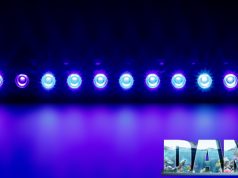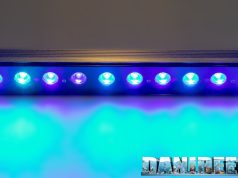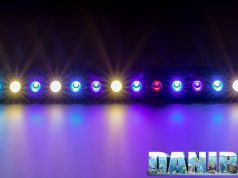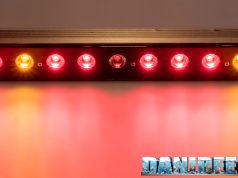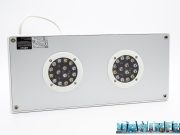Our new method DaniReef LAB for PAR measurement
During the long nights spent on our forum we always wondered how could we compare PAR from different ceiling lights. Even though we had the perfect device, the Quantum Meter MQ-510 di Apogee, we always referred only to the value measured at the centre at 20 cm of distance, more or less.
The Quantum Meter MQ-510 measures the PAR, expressed in PFFD that is photosynthetic photon flux density in μmol m-2 s-1. This device is calibrated to work underwater, so if it’s in air the measured value has to be divided by 1,32 that’s the dive factor. We have to do the conversion. The values you’re going to see are correct.

We decided to make a square base of 70×70 cm, we set 17 fiducial points where we placed the sensor Quantum Meter MQ-510 and we also made 3 lifts of 20, 40 and 60 cm for the ceiling light, in order to have the same distance from the sensor. This will allow us to create the curves which can be compared to other ceiling lights’s, all tested at the same distances. Notice that this distance is measured between the base of the sensor and the ceiling light. In reality it should be decreased of 3,5 cm that is the height of the measurement cylinder and increased by 0,5 cm that’s the dimension of the spacers that lift the ceiling light.
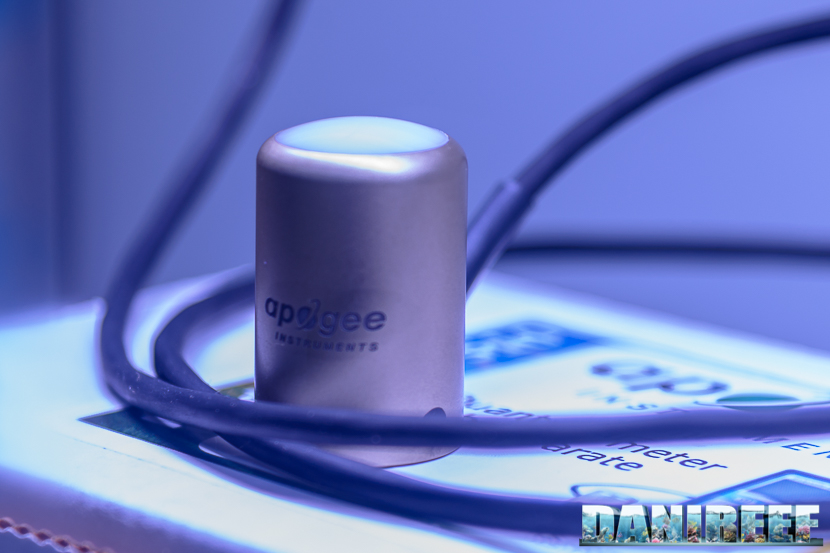
In total the three measurements are made from 17, 37 and 57 cm of distance. Because they’ve been done in air they will be corrected.
PAR measurement from 17 cm of distance

The ceiling light has been placed at 17 cm of the display. The points not indicated on the panel have been estimated in the following chart.
Here the collected values:

And this is the corresponding chart. We are using the same scale for ceiling lights with similar power. That is, if you read the article of the Cetus 2, you’ll find the same evaluation scale.

While the ceiling light is so close to the sensor plus the fact that has a single cluster, it’s obvious that the PAR quickly decrease on all the sides. But differently from other ceiling lights the Reef Flare S diffuses the light more uniformely. The peak value is lower but the coverage is better then the average.
PAR measurement from 37 cm of distance

This is the condition of the test. Below there are the chart and the device, above the ceiling light placed on the aluminum bars.
Here the collected values:

And the corresponding chart.

With a bigger space between ceiling lights and sensor, it decreases the difference between PAR in the middle and on the sides. The light spreads a lot, also because of the characteristics of this particular ceiling light, but the value in the middle decreases from 623 to 145μmol m-2 s-1.
It stands out that the full coverage.
PAR measurement from 57 cm of distance

This is the condition of the test. Below there’s the chart, from this distance the device it is very visible, and the ceiling light placed on the aluminum bars. Even visually the illuminated area is a lot wider, so the specific power per cm decreases.
Here the collected values:

And that’s the corresponding chart.

Increasing even more the space between ceiling light and sensor, it decreases even more the difference between PAR in the middle and on the sides. There’s more uniformity, as expected, but the whole power decreases a lot. The light spreads, while the central value decreases from 623 to 145 to 64 μmol m-2 s-1.
The PAR in the middle in the different configurations
Let’s continue with our technical measurements. We can see how, in a chart, the PAR collected in the middle decrease in the three different distances of our tests.

Energy variation of the Reef Flare S depending on the distances

This is the most significant and most comparable data: the energy variation. We calculated the volumes of the three surfaces previously seen. It’s obvious that moving away from the ceiling light the PAR decrease, also because the light illuminates a wider space. In this way you can consider all the light energy contained in the 60×60 cm area subtended by the ceiling light. And the three values of 332,408, 248.139 and 154.652 assume a different connotation compared to the values in the middle. When the first ones decrease because of the increasing of the distances, the subtended area, that is the energy, decreases less. You can see that the ceiling light prefers a central distribution of the light.
Technically speaking, this is a ceiling light designed to be kept rather close to the water, in order that the light can reflect on the glass and lighting uniformely the aquarium.
Values per channel in the middle in the three distances
We also measured the values per each channel, but only in the middle, in order to give you an idea of the contribution of the different channels on the PAR produced.

Let’s see the measured values:
| Distance = 17 cm | Distance = 37 cm | Distance = 57 cm | |
| Channel 1 UV | 36 μmol m-2 s-1 | 9 μmol m-2 s-1 | 3 μmol m-2 s-1 |
| Channel 2 Purple | 36 μmol m-2 s-1 | 9 μmol m-2 s-1 | 3 μmol m-2 s-1 |
| Channel 3 Indigo | 189 μmol m-2 s-1 | 45 μmol m-2 s-1 | 19 μmol m-2 s-1 |
| Channel 4 Royal Blue | 123 μmol m-2 s-1 | 29 μmol m-2 s-1 | 12 μmol m-2 s-1 |
| Channel 5 Green | 19 μmol m-2 s-1 | 5 μmol m-2 s-1 | 2 μmol m-2 s-1 |
| Channel 6 Red | 41 μmol m-2 s-1 | 9 μmol m-2 s-1 | 3 μmol m-2 s-1 |
| Channel 7 White | 213 μmol m-2 s-1 | 50 μmol m-2 s-1 | 21 μmol m-2 s-1 |
The White channel produces more PAR than Royal Blue. But in any case, White, Blue and Indigo produce the main part of the PAR. These three channels made 80% of the whole light.
Let’s continue on page three with price, comparison with other ceiling lights and our final comment.




